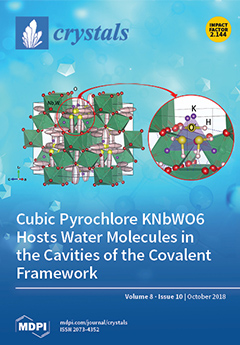This work explores the effect of lattice solvent on the observed solid-state spin-transition of a previously reported dinuclear Fe(II) triple helicate series
1–
3 of the general form [Fe
II2L3](BF
4)
4(CH
3CN)
n, where
L is the Schiff base condensation product of imidazole-4-carbaldehyde with 4,4-diaminodiphenylmethane (
L1), 4,4′-diaminodiphenyl sulfide (
L2) and 4,4′-diaminodiphenyl ether (
L3) respectively, and
1 is the complex when
L =
L1, 2 when
L =
L2 and
3 when
L =
L3 (Craze, A.R.; Sciortino, N.F.; Bhadbhade, M.M.; Kepert, C.J.; Marjo, C.E.; Li, F. Investigation of the Spin Crossover Properties of Three Dinuclear Fe(II) Triple Helicates by Variation of the Steric Nature of the Ligand Type.
Inorganics. 2017,
5 (4), 62). Desolvation of
1 and
2 during measurement resulted not only in a decrease in T
1/2 and completeness of spin-crossover (SCO) but also a change in the number of steps in the spin-profile. Compounds
1 and
2 were observed to change from a two-step 70% complete transition when fully solvated, to a single-step half complete transition upon desolvation. The average T
1/2 value of the two-steps in the solvated materials was equivalent to the single T
1/2 of the desolvated sample. Upon solvent loss, the magnetic profile of
3 experienced a transformation from a gradual SCO or weak antiferromagnetic interaction to a single half-complete spin-transition. Variable temperature single-crystal structures are presented and the effects of solvent molecules are also explored crystallographically and via a Hirshfeld surface analysis. The spin-transition profiles of
1–
3 may provide further insight into previous discrepancies in dinuclear triple helicate SCO research reported by the laboratories of Hannon and Gütlich on analogous systems (Tuna, F.; Lees, M. R.; Clarkson, G. J.; Hannon, M. J. Readily Prepared Metallo-Supramolecular Triple Helicates Designed to Exhibit Spin-Crossover Behaviour.
Chem. Eur. J. 2004,
10, 5737–5750 and Garcia, Y.; Grunert, C. M.; Reiman, S.; van Campenhoudt, O.; Gütlich, P. The Two-Step Spin Conversion in a Supramolecular Triple Helicate Dinuclear Iron(II) Complex Studied by Mössbauer Spectroscopy.
Eur. J. Inorg. Chem. 2006, 3333–3339).
Full article





